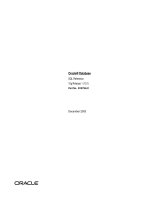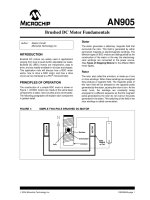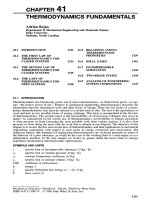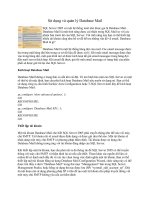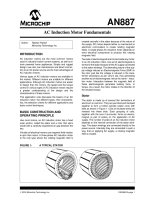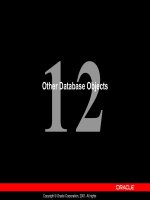Database Fundamentals doc
Bạn đang xem bản rút gọn của tài liệu. Xem và tải ngay bản đầy đủ của tài liệu tại đây (5.06 MB, 282 trang )
Database
Fundamentals
Neeraj Sharma, Liviu Perniu, Raul F. Chong, Abhishek Iyer, Chaitali Nandan,
Adi-Cristina Mitea, Mallarswami Nonvinkere, Mirela Danubianu
A book for the community by the community
F I R S T E D I T I O N
Database Fundamentals 4
First Edition (November 2010)
© Copyright IBM Corporation 2010. All rights reserved.
IBM Canada
8200 Warden Avenue
Markham, ON
L6G 1C7
Canada
This edition covers IBM
®
DB2
®
Express-C Version 9.7 for Linux
®,
UNIX
®
and
Windows
®
.
5
Notices
This information was developed for products and services offered in the U.S.A.
IBM may not offer the products, services, or features discussed in this document in other countries.
Consult your local IBM representative for information on the products and services currently available
in your area. Any reference to an IBM product, program, or service is not intended to state or imply
that only that IBM product, program, or service may be used. Any functionally equivalent product,
program, or service that does not infringe any IBM intellectual property right may be used instead.
However, it is the user's responsibility to evaluate and verify the operation of any non-IBM product,
program, or service.
IBM may have patents or pending patent applications covering subject matter described in this
document. The furnishing of this document does not grant you any license to these patents. You can
send license inquiries, in writing, to:
IBM Director of Licensing
IBM Corporation
North Castle Drive
Armonk, NY 10504-1785
U.S.A.
For license inquiries regarding double-byte character set (DBCS) information, contact the IBM
Intellectual Property Department in your country or send inquiries, in writing, to:
Intellectual Property Licensing
Legal and Intellectual Property Law
IBM Japan, Ltd.
3-2-12, Roppongi, Minato-ku, Tokyo 106-8711
The following paragraph does not apply to the United Kingdom or any other country where
such provisions are inconsistent with local law: INTERNATIONAL BUSINESS MACHINES
CORPORATION PROVIDES THIS PUBLICATION "AS IS" WITHOUT WARRANTY OF ANY KIND,
EITHER EXPRESS OR IMPLIED, INCLUDING, BUT NOT LIMITED TO, THE IMPLIED
WARRANTIES OF NON-INFRINGEMENT, MERCHANTABILITY OR FITNESS FOR A
PARTICULAR PURPOSE. Some states do not allow disclaimer of express or implied warranties in
certain transactions, therefore, this statement may not apply to you.
This information could include technical inaccuracies or typographical errors. Changes are
periodically made to the information herein; these changes will be incorporated in new editions of the
publication. IBM may make improvements and/or changes in the product(s) and/or the program(s)
described in this publication at any time without notice.
Any references in this information to non-IBM Web sites are provided for convenience only and do
not in any manner serve as an endorsement of those Web sites. The materials at those Web sites
are not part of the materials for this IBM product and use of those Web sites is at your own risk.
IBM may use or distribute any of the information you supply in any way it believes appropriate without
incurring any obligation to you.
Database Fundamentals 6
The licensed program described in this document and all licensed material available for it are
provided by IBM under terms of the IBM Customer Agreement, IBM International Program License
Agreement or any equivalent agreement between us.
Any performance data contained herein was determined in a controlled environment. Therefore, the
results obtained in other operating environments may vary significantly. Some measurements may
have been made on development-level systems and there is no guarantee that these measurements
will be the same on generally available systems. Furthermore, some measurements may have been
estimated through extrapolation. Actual results may vary. Users of this document should verify the
applicable data for their specific environment.
Information concerning non-IBM products was obtained from the suppliers of those products, their
published announcements or other publicly available sources. IBM has not tested those products and
cannot confirm the accuracy of performance, compatibility or any other claims related to non-IBM
products. Questions on the capabilities of non-IBM products should be addressed to the suppliers of
those products.
All statements regarding IBM's future direction or intent are subject to change or withdrawal without
notice, and represent goals and objectives only.
This information contains examples of data and reports used in daily business operations. To
illustrate them as completely as possible, the examples include the names of individuals, companies,
brands, and products. All of these names are fictitious and any similarity to the names and addresses
used by an actual business enterprise is entirely coincidental.
COPYRIGHT LICENSE:
This information contains sample application programs in source language, which illustrate
programming techniques on various operating platforms. You may copy, modify, and distribute these
sample programs in any form without payment to IBM, for the purposes of developing, using,
marketing or distributing application programs conforming to the application programming interface
for the operating platform for which the sample programs are written. These examples have not been
thoroughly tested under all conditions. IBM, therefore, cannot guarantee or imply reliability,
serviceability, or function of these programs. The sample programs are provided "AS IS", without
warranty of any kind. IBM shall not be liable for any damages arising out of your use of the sample
programs.
References in this publication to IBM products or services do not imply that IBM intends to make
them available in all countries in which IBM operates.
If you are viewing this information softcopy, the photographs and color illustrations may not
appear.
7
Trademarks
IBM, the IBM logo, and ibm.com are trademarks or registered trademarks of International Business
Machines Corp., registered in many jurisdictions worldwide. Other product and service names might
be trademarks of IBM or other companies. A current list of IBM trademarks is available on the Web at
“
Copyright and trademark information” at www.ibm.com/legal/copytrade.shtml.
Java and all Java-based trademarks are trademarks of Sun Microsystems, Inc. in the United States,
other countries, or both.
Microsoft and Windows are trademarks of Microsoft Corporation in the United States, other countries,
or both.
Linux is a registered trademark of Linus Torvalds in the United States, other countries, or both.
UNIX is a registered trademark of The Open Group in the United States and other countries.
Other company, product, or service names may be trademarks or service marks of others.
Table of Contents
Preface 15
Who should read this book? 15
How is this book structured? 15
A book for the community 15
Conventions 15
What’s next? 16
About the Authors 17
Contributors 19
Acknowledgements 21
Chapter 1 - Databases and information models 23
1.1 What is a database? 23
1.2 What is a database management system? 23
1.2.1 The evolution of database management systems 24
1.3 Introduction to information models and data models 26
1.4 Types of information models 27
1.4.1 Network model 28
1.4.2 Hierarchical model 28
1.4.3 Relational model 29
1.4.4 Entity-Relationship model 30
1.4.5 Object-relational model 31
1.4.6 Other data models 32
1.5 Typical roles and career path for database professionals 32
1.5.1 Data Architect 32
1.5.2 Database Architect 32
1.5.3 Database Administrator (DBA) 33
1.5.4 Application Developer 34
1.6 Summary 34
1.7 Exercises 35
1.8 Review questions 35
Chapter 2 – The relational data model 37
2.1 Relational data model: The big picture 37
2.2 Basic concepts 38
2.2.1 Attributes 38
2.2.2 Domains 39
2.2.3 Tuples 40
2.2.4 Relations 40
2.2.5 Schemas 41
2.2.6 Keys 41
2.3 Relational data model constraints 44
2.3.1 Entity integrity constraint 44
2.3.2 Referential integrity constraint 45
2.3.3 Semantic integrity constraints 46
2.4 Relational algebra 49
Database Fundamentals 10
2.4.1 Union 49
2.4.2 Intersection 49
2.4.3 Difference 50
2.4.4 Cartesian product 51
2.4.5 Selection 52
2.4.6 Projection 53
2.4.7 Join 54
2.4.8 Division 56
2.5. Relational calculus 57
2.5.1 Tuple-oriented relational calculus 58
2.5.2 Domain-oriented relational calculus 59
2.6 Summary 60
2.7 Exercises 60
2.8 Review questions 62
Chapter 3 – The conceptual data model 65
3.1 Conceptual, logical and physical modeling: The big picture 65
3.2 What is a model? 67
3.2.1 Data model 67
3.2.2 Database model 67
3.2.3 Conceptual data model concepts 68
3.3 A case study involving a Library Management System - Part 1 of 3 77
3.3.1 Developing the conceptual model 77
3.4 Summary 85
3.5 Exercises 85
3.6 Review questions 85
Chapter 4 – Relational Database Design 89
4.1 The problem of redundancy 89
4.1.1 Insertion Anomalies 90
4.1.2 Deletion Anomalies 90
4.1.3 Update Anomalies 90
4.2. Decompositions 91
4.3. Functional Dependencies 92
4.4 Properties of Functional Dependencies 94
4.4.1 Armstrong’s Axioms 94
4.4.2 Computing the closure set of attributes 95
4.4.3 Entailment 96
4.5 Normal Forms 96
4.5.1 First Normal Form (1NF) 96
4.5.2 Second Normal Form (2NF) 98
4.5.3 Third Normal Form (3NF) 99
4.5.4 Boyce-Codd Normal Form (BCNF) 100
4.6 Properties of Decompositions 101
4.6.1 Lossless and Lossy Decompositions 102
4.6.2 Dependency-Preserving Decompositions 103
4.7 Minimal Cover 103
11
4.8 Synthesis of 3NF schemas 105
4.9 3NF decomposition 106
4.10 The Fourth Normal Form (4NF) 106
4.10.1 Multi-valued dependencies 107
4.11 Other normal forms 108
4.12 A case study involving a Library Management System - Part 2 of 3 108
4.13 Summary 111
4.14 Exercises 112
4.15 Review questions 112
Chapter 5 – Introduction to SQL 115
5.1 History of SQL 115
5.2 Defining a relational database schema in SQL 116
5.2.1 Data Types 116
5.2.2 Creating a table 117
5.2.3 Creating a schema 120
5.2.4 Creating a view 121
5.2.5 Creating other database objects 121
5.2.6 Modifying database objects 121
5.2.7 Renaming database objects 122
5.3 Data manipulation with SQL 122
5.3.1 Selecting data 122
5.3.2 Inserting data 123
5.3.3 Deleting data 124
5.3.4 Updating data 124
5.4 Table joins 125
5.4.1 Inner joins 125
5.4.2 Outer joins 126
5.5 Union, intersection, and difference operations 128
5.5.1 Union 129
5.5.2 Intersection 130
5.5.3 Difference (Except) 130
5.6 Relational operators 131
5.6.1 Grouping operators 131
5.6.2 Aggregation operators 132
5.6.3 HAVING Clause 132
5.7 Sub-queries 132
5.7.1 Sub-queries returning a scalar value 133
5.7.2 Sub-queries returning vector values 133
5.7.3 Correlated sub-query 133
5.7.4 Sub-query in FROM Clauses 134
5.8 Mapping of object-oriented concepts to relational concepts 134
5.10 A case study involving a Library Management System - Part 3 of 3 135
5.9 Summary 139
5.10 Exercises 140
5.11 Review questions 140
Database Fundamentals 12
Chapter 6 – Stored procedures and functions 143
6.1 Working with IBM Data Studio 143
6.1.1 Creating a project 144
6.2 Working with stored procedures 146
6.2.1 Types of procedures 147
6.2.2 Creating a stored procedure 148
6.2.3 Altering and dropping a stored procedure 152
6.3 Working with functions 153
6.3.1 Types of functions 153
6.3.2 Creating a function 154
6.3.3 Invoking a function 155
6.3.4 Altering and dropping a function 156
6.4 Summary 157
6.5 Exercises 157
6.6 Review Questions 157
Chapter 7 – Using SQL in an application 161
7.1 Using SQL in an application: The big picture 161
7.2 What is a transaction? 162
7.3 Embedded SQL 163
7.3.1 Static SQL 163
7.3.2 Dynamic SQL 168
7.3.3 Static vs. dynamic SQL 172
7.4 Database APIs 173
7.4.1 ODBC and the IBM Data Server CLI driver 173
7.4.2 JDBC 175
7.5 pureQuery 176
7.5.1 IBM pureQuery Client Optimizer 179
7.6 Summary 179
7.7 Exercises 180
7.8 Review Questions 180
Chapter 8 – Query languages for XML 183
8.1 Overview of XML 183
8.1.1 XML Elements and Database Objects 183
8.1.2 XML Attributes 185
8.1.3 Namespaces 186
8.1.4 Document Type Definitions 187
8.1.5 XML Schema 188
8.2 Overview of XML Schema 189
8.2.1 Simple Types 189
8.2.2 Complex Types 191
8.2.3 Integrity constraints 192
8.2.4 XML Schema evolution 193
8.3 XPath 194
8.3.1 The XPath data model 194
8.3.2 Document Nodes 194
13
8.3.3 Path Expressions 196
8.3.4 Advanced Navigation in XPath 196
8.3.5 XPath Semantics 196
8.3.6 XPath Queries 198
8.4 XQuery 199
8.4.1 XQuery basics 200
8.4.2 FLWOR expressions 200
8.4.3 Joins in XQuery 201
8.4.4 User-defined functions 202
8.4.5 XQuery and XML Schema 202
8.4.6 Grouping and aggregation 202
8.4.7 Quantification 204
8.5 XSLT 204
8.6 SQL/XML 206
8.6.1 Encoding relations as XML Documents 206
8.6.2 Storing and publishing XML documents 207
8.6.3 SQL/XML Functions 207
8.7 Querying XML documents stored in tables 211
8.8 Modifying data 212
8.8.1 XMLPARSE 212
8.8.2 XMLSERIALIZE 213
8.8.3 The TRANSFORM expression 213
8.9 Summary 214
8.10 Exercises 215
8.11 Review questions 215
Chapter 9 – Database Security 221
9.1 Database security: The big picture 221
9.1.1 The need for database security 222
9.1.2 Access control 224
9.1.3 Database security case study 225
9.1.4 Views 231
9.1.5 Integrity Control 231
9.1.6 Data encryption 231
9.2 Security policies and procedures 232
9.2.1 Personnel control 232
9.2.2 Physical access control 232
9.3 Summary 233
9.4 Exercises 233
9.5 Review Questions 233
Chapter 10 – Technology trends and databases 235
10.1 What is Cloud computing? 235
10.1.1 Characteristics of the Cloud 236
10.1.2 Cloud computing service models 237
10.1.3 Cloud providers 237
10.1.4 Handling security on the Cloud 241
Database Fundamentals 14
10.1.5 Databases and the Cloud 242
10.2 Mobile application development 243
10.2.1 Developing for a specific device 244
10.2.2 Developing for an application platform 245
10.2.3 Mobile device platform 246
10.2.4 Mobile application development platform 247
10.2.5 The next wave of mobile applications 248
10.2.6 DB2 Everyplace 248
10.3 Business intelligence and appliances 249
10.4 db2university.com: Implementing an application on the Cloud (case study) 249
10.4.1 Moodle open source course management system 250
10.4.2 Enabling openID sign-in 253
10.4.3 Running on the Amazon Cloud 254
10.4.4 Using an Android phone to retrieve course marks 255
10.5 Summary 256
Appendix A – Solutions to review questions 259
Appendix B – Up and running with DB2 264
B.1 DB2: The big picture 264
B.2 DB2 Packaging 265
B.2.1 DB2 servers 265
B.2.2 DB2 Clients and Drivers 266
B.3 Installing DB2 267
B.3.1 Installation on Windows 267
B.3.2 Installation on Linux 268
B.4 DB2 tools 268
B.4.1 Control Center 268
B.4.2 Command Line Tools 270
B.5 The DB2 environment 273
B.6 DB2 configuration 274
B.7 Connecting to a database 275
B.8 Basic sample programs 276
B.9 DB2 documentation 278
Resources 279
Web sites 279
Books 279
References 280
Contact 281
Preface
Keeping your skills current in today's world is becoming increasingly challenging. There are
too many new technologies being developed, and little time to learn them all. The DB2® on
Campus Book Series has been developed to minimize the time and effort required to learn
many of these new technologies.
This book helps new database professionals understand database concepts with the right
blend of breadth and depth of information.
Who should read this book?
This book is tailored for new database enthusiasts, application developers, database
administrators, and anyone with an interest in the subject and looking to get exposure such
as university students and new graduates.
How is this book structured?
This book is divided into chapters, starting with the basic database concepts and
information models in Chapter 1. Chapter 2 covers relational data models. Chapter 3 and 4
explain conceptual modeling and relational database design. In Chapters 5, 6 and 7 the
focus is geared towards SQL. Chapter 8 highlights XML data storage and retrieval via SQL
and XQuery. Chapter 9 addresses database security aspects. The book then concludes
with an overview of various other key technologies and relevant applications that are
increasingly popular in the industry today.
Exercises and review questions can be found with most chapters. The solutions have been
provided in Appendix A.
A book for the community
This book was created by a community of university professors, students, and
professionals (including IBM employees). Members from around the world have
participated in developing this book. The online version of this book is released to the
community at no charge. If you would like to provide feedback, contribute new material,
improve existing material, or help with translating this book to another language, please
send an email of your planned contribution to
with the subject
“Database fundamentals book feedback”.
Conventions
Many examples of commands, SQL statements, and code are included throughout the
book. Specific keywords are written in uppercase bold. For example: A NULL represents an
unknown state. Commands are shown in lowercase bold. For example: The dir
command lists all files and subdirectories on Windows. SQL statements are shown in
Database Fundamentals 16
upper case bold. For example: Use the SELECT statement to retrieve information from a
table.
Object names used in our examples are shown in bold italics. For example: The flights
table has five columns.
Italics are also used for variable names in the syntax of a command or statement. If the
variable name has more than one word, it is joined with an underscore. For example:
CREATE TABLE table_name
What’s next?
We recommend that you review the following books in this book series for more details
about related topics:
Getting started with DB2 Express-C
Getting started with InfoSphere Data Architect
Getting started with data warehousing
Getting started with DB2 application development
The following figure shows all the different eBooks in the DB2 on Campus book series
available free at
db2university.com
The DB2 on Campus book series
17
About the Authors
Neeraj Sharma is a senior IT specialist at the Dynamic Warehousing Center of
Competency, IBM India Software Labs. His primary role is design, configuration and
implementation of large data warehouses across various industry domains; implementation
of custom proof of concept (POC) exercises, and execution of performance benchmarks at
customer's request. He holds a bachelor’s degree in electronics and communication
engineering and a master’s degree in software systems.
Liviu Perniu is an Associate Professor in the Automation Department at Transilvania
University of Brasov, Romania, teaching courses in the area of Data Requirements,
Analysis, and Modeling. He is an IBM 2006 Faculty Award recipient as part of the Eclipse
Innovation Awards program.
Raul F. Chong is the DB2 on Campus program manager based at the IBM Toronto
Laboratory, and a DB2 technical evangelist. His main responsibility is to grow the DB2
community around the world. Raul joined IBM in 1997 and has held numerous positions in
the company. As a DB2 consultant, Raul helped IBM business partners with migrations
from other relational database management systems to DB2, as well as with database
performance and application design issues. As a DB2 technical support specialist, Raul
has helped resolve DB2 problems on the OS/390®, z/OS®, Linux®, UNIX® and Windows
platforms. Raul has taught many DB2 workshops, has published numerous articles, and
has contributed to the DB2 Certification exam tutorials. Raul has summarized many of his
DB2 experiences through the years in his book Understanding DB2 - Learning Visually with
Examples 2nd Edition (ISBN-10: 0131580183) for which he is the lead author. He has also
co-authored the book DB2 SQL PL Essential Guide for DB2 UDB on Linux, UNIX,
Windows, i5/OS, and z/OS (ISBN 0131477005), and is the project lead and co-author of
many of the books in the DB2 on Campus book series.
Abhishek Iyer is an engineer at the Warehousing Center of Competency, IBM India
Software Laboratory. His primary role is to create proof of concepts and execute
performance benchmarks on customer requests. His expertise includes data warehouse
implementation and data mining. He holds a bachelor’s degree in computer science.
Chaitali Nandan is a software engineer working in the DB2 Advanced Technical Support
team based at the IBM India Software Laboratory. Her primary role is to provide first relief
and production support to DB2 Enterprise customers. She specializes in critical problem
solving skills for DB2 production databases. She holds a Bachelor of Engineering degree in
Information Technology.
Adi-Cristina Mitea is an associate professor at the Computer Science Department,
“Hermann Oberth” Faculty of Engineering, “Lucian Blaga” University of Sibiu, Romania.
She teaches courses in the field of databases, distributed systems, parallel and distributed
algorithms, fault tolerant systems and others. Her research activities are in these same
areas. She holds a bachelor’s degree and a Ph.D in computer science.
Database Fundamentals 18
Mallarswami Nonvinkere is a pureXML® specialist with IBM’s India Software Laboratory
and works for the DB2 pureXML enablement team in India. He works with IBM customers
and ISVs to help them understand the use of pureXML technology and develop high
performance applications using XML. Mallarswami helps customers with best practices and
is actively involved in briefing customers about DB2 related technologies. He has been a
speaker at various international conferences including IDUG Australasia, IDUG India and
IMTC and has presented at various developerWorks
®
forums.
Mirela Danubianu is a lecturer at Stefan cel Mare University of Suceava, Faculty of
Electrical Engineering and Computer Science. She received a MS in Computer Science at
University of Craiova (1985 – Automatizations and Computers) and other in Economics at
Stefan cel Mare University of Suceava, (2009 - Management). She holds a PhD in
Computers Science from Stefan cel Mare University of Suceava (2006 - Contributions to
the development of data mining and knowledge methods and techniques). Her current
research interests include databases theory and implementation, data mining and data
warehousing, application of advanced information technology in economics and health care
area. Mirela has co-authored 7 books and more than 25 papers. She has participated in
more than 15 conferences, and is a member of the International Program Committee in
three conferences.
Contributors
The following people edited, reviewed, provided content, and contributed significantly to
this book.
Contributor Company/University Position/Occupation Contribution
Agatha
Colangelo
ION Designs, Inc Data Modeler Developed the core
table of contents of the
book
Cuneyt Goksu VBT Vizyon Bilgi
Teknolojileri
DB2 SME and IBM
Gold Consultant
Technical review
Marcus
Graham
IBM US Software developer English and technical
review of Chapter 10
Amna Iqbal IBM Toronto Lab Quality Assurance -
Lotus Foundations
English review of the
entire book except
chapters 5 and 7
Leon
Katsnelson
IBM Toronto Lab Program Director, IBM
Data Servers
Technical review, and
contributor to Chapter
10 content
Jeff (J.Y.) Luo IBM Toronto Lab Technical Enablement
Specialist
English review of
chapter 7
Fraser
McArthur
IBM Toronto Lab Information
Management
Evangelist
Technical review
Danna
Nicholson
IBM US STG ISV Enablement,
Web Services
English review of the
entire book.
Rulesh
Rebello
IBM India Advisory Manager -
IBM Software Group
Client Support
Technical review
Suresh Sane DST Systems, Inc Database Architect Review of various
chapters, especially
those related to SQL
Nadim Sayed IBM Toronto Lab User-Centered Design
Specialist
English review of
chapter 1
Database Fundamentals 20
Ramona Truta University of Toronto Lecturer Developed the core
table of contents of the
book.
Acknowledgements
We greatly thank the following individuals for their assistance in developing materials
referenced in this book.
Natasha Tolub for designing the cover of this book.
Susan Visser for assistance with publishing this book.
1
Chapter 1 - Databases and information models
Data is one of the most critical assets of any business. It is used and collected practically
everywhere, from businesses trying to determine consumer patterns based on credit card
usage, to space agencies trying to collect data from other planets. Data, as important as it
is, needs robust, secure, and highly available software that can store and process it
quickly. The answer to these requirements is a solid and a reliable database.
Database software usage is pervasive, yet it is taken for granted by the billions of daily
users worldwide. Its presence is everywhere-from retrieving money through an automatic
teller machine to badging access at a secure office location.
This chapter provides you an insight into the fundamentals of database management
systems and information models.
1.1 What is a database?
Since its advent, databases have been among the most researched knowledge domains in
computer science. A database is a repository of data, designed to support efficient data
storage, retrieval and maintenance. Multiple types of databases exist to suit various
industry requirements. A database may be specialized to store binary files, documents,
images, videos, relational data, multidimensional data, transactional data, analytic data, or
geographic data to name a few.
Data can be stored in various forms, namely tabular, hierarchical and graphical forms. If
data is stored in a tabular form then it is called a relational database. When data is
organized in a tree structure form, it is called a hierarchical database. Data stored as
graphs representing relationships between objects is referred to as a network database.
In this book, we focus on relational databases.
1.2 What is a database management system?
While a database is a repository of data, a database management system, or simply
DBMS, is a set of software tools that control access, organize, store, manage, retrieve and
maintain data in a database. In practical use, the terms database, database server,
Database Fundamentals 24
database system, data server, and database management systems are often used
interchangeably.
Why do we need database software or a DBMS? Can we not just store data in simple text
files for example? The answer lies in the way users access the data and the handle of
corresponding challenges. First, we need the ability to have multiple users insert, update
and delete data to the same data file without "stepping on each other's toes". This means
that different users will not cause the data to become inconsistent, and no data should be
inadvertently lost through these operations. We also need to have a standard interface for
data access, tools for data backup, data restore and recovery, and a way to handle other
challenges such as the capability to work with huge volumes of data and users. Database
software has been designed to handle all of these challenges.
The most mature database systems in production are relational database management
systems (RDBMS’s). RDBMS's serve as the backbone of applications in many industries
including banking, transportation, health, and so on. The advent of Web-based interfaces
has only increased the volume and breadth of use of RDBMS, which serve as the data
repositories behind essentially most online commerce.
1.2.1 The evolution of database management systems
In the 1960s, network and hierarchical systems such as CODASYL and IMSTM were the
state-of-the-art technology for automated banking, accounting, and order processing
systems enabled by the introduction of commercial mainframe computers. While these
systems provided a good basis for the early systems, their basic architecture mixed the
physical manipulation of data with its logical manipulation. When the physical location of
data changed, such as from one area of a disk to another, applications had to be updated
to reference the new location.
A revolutionary paper by E.F. Codd, an IBM San Jose Research Laboratory employee in
1970, changed all that. The paper titled “A relational model of data for large shared data
banks” [1.1] introduced the notion of data independence, which separated the physical
representation of data from the logical representation presented to applications. Data could
be moved from one part of the disk to another or stored in a different format without
causing applications to be rewritten. Application developers were freed from the tedious
physical details of data manipulation, and could focus instead on the logical manipulation of
data in the context of their specific application.
Figure 1.1 illustrates the evolution of database management systems.
Chapter 1 - Databases and information models 25
Figure 1.1 Evolution of database management systems
The above figure describes the evolution of database management systems with the
relational model that provide for data independence. IBM's System R was the first system
to implement Codd's ideas. System R was the basis for SQL/DS, which later became DB2.
It also has the merit to introduce SQL, a relational database language used as a standard
today, and to open the door for commercial database management systems.
Today, relational database management systems are the most used DBMS's and are
developed by several software companies. IBM is one of the leaders in the market with
DB2 database server. Other relational DBMS's include Oracle, Microsoft SQL Server,
INGRES, PostgreSQL, MySQL, and dBASE.
As relational databases became increasingly popular, the need to deliver high performance
queries has arisen. DB2's optimizer is one of the most sophisticated components of the
product. From a user's perspective, you treat DB2's optimizer as a black box, and pass any
SQL query to it. The DB2's optimizer will then calculate the fastest way to retrieve your
data by taking into account many factors such as the speed of your CPU and disks, the
amount of data available, the location of the data, the type of data, the existence of
indexes, and so on. DB2's optimizer is cost-based.
As increased amounts of data were collected and stored in databases, DBMS's scaled. In
DB2 for Linux, UNIX and Windows, for example, a feature called Database Partitioning
Feature (DPF) allows a database to be spread across many machines using a shared-
nothing architecture. Each machine added brings its own CPUs and disks; therefore, it is
easier to scale almost linearly. A query in this environment is parallelized so that each
machine retrieves portions of the overall result.
Next in the evolution of DBMS's is the concept of extensibility. The Structured Query
Language (SQL) invented by IBM in the early 1970's has been constantly improved
through the years. Even though it is a very powerful language, users are also empowered


